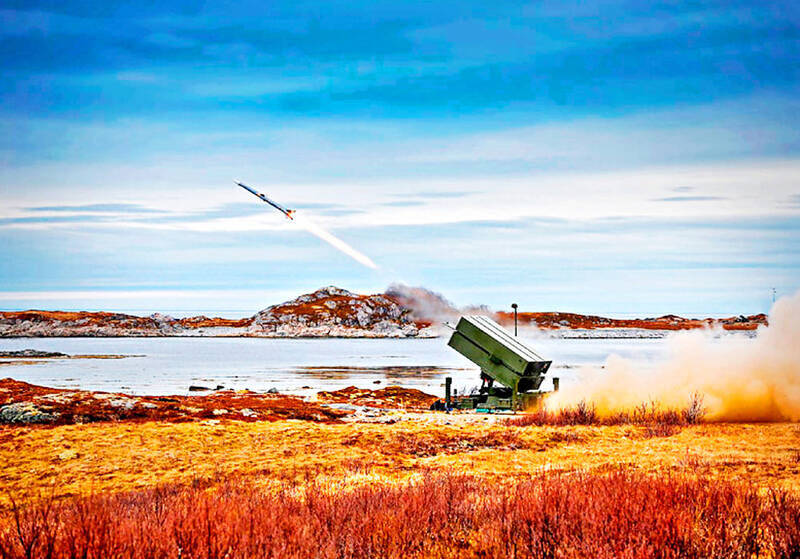Next year’s national defense budget would include NT$35.7 billion (US$1.17 billion) to purchase three National Advanced Surface-to-Air Missile Systems (NASAMS) from the US, with plans to purchase a further nine systems at a cost of about NT$110 billion, a military source said yesterday.
The first and second phases of procurement, in which the military would purchase three and nine NASAMS respectively, would proceed simultaneously to accelerate the deployment of the air defense missile systems in Taiwan, the source said.
The budget for the second phase of procurement would be included under the Special Act for Strengthening Economic, Social and National Security Resilience in Response to International Circumstances (因應國際情勢強化經濟社會及民生國安韌性特別條例), they said.

Photo: Screen grab from Kongsberg Defence and Aerospace’s Web site
The US Defense Security Cooperation Agency in October last year said that it would sell Taiwan three NASAMS and related equipment, including three AN/MPQ-64F1 Sentinel radar systems, 123 AIM-120 advanced medium-range air-to air missile (AMRAAM) extended range missiles, two AMRAAM-C8 guidance modules and four multifunctional information distribution systems, primarily intended to defend key centers and air force bases.
The Ministry of National Defense has earmarked the NASAMS procurement in next year’s defense budget, designating it as phase one.
In phase two, the military would purchase a further nine NASAMS, as well as 339 missiles of various types at a total cost of about NT$110 billion to defend naval bases, and air force and navy radar stations.

Photo: Liu Yu-chieh, Taipei Times
Many countries in Europe and North America deploy NASAMS to defend key centers, urban areas and airports.
The air-defense missile system is especially valuable because of its flexibility, the source said.
It can launch AIM-120 AMRAAM extended range missiles and AIM-9X Block II Sidewinder short-range missiles.
In addition, missiles on fighter jets can be transferred to the system for use if runways are destroyed and fighter jets are unable to take off.
Moreover, all of the US-made missiles are compatible with Taiwan’s F-16V fighter jets.
The AIM-120 AMRAAM extended range missiles have a range of up to 50km, filling the gap between Taiwan’s long-range and short-range missiles, strengthening the nation’s overall air-defense network.
In related news, a military source yesterday said that Taiwan has purchased 2,612 FIM-92 Stinger portable air-defense missiles from the US, with the first batch of 500 scheduled to be delivered before the end of this year.
This first batch would be split evenly between the army and the navy, the source said.
The army’s second batch of Stinger missiles is scheduled for delivery in 2031, including 1,985 missiles, 549 launch systems and 549 Identification Friend or Foe (IFF) transponders.
The navy’s second batch is also planned for 2031, consisting of 45 missiles, 15 launch systems and 15 IFF transponders.
The remainder of the Stinger missiles would be allocated to the military police, with a 2028 delivery of 63 missiles, 21 launch systems and 21 IFF transponders, and a 2030 delivery of 28 missiles.
The FIM-92 missile, which gained prominence during Russia’s invasion of Ukraine, has been introduced into several domestic military units.
During this year’s Han Kuang exercises, Marine Corps, military police and army troops were equipped with newly acquired Stinger missiles to provide short-range air-defense support.

AGING: As of last month, people aged 65 or older accounted for 20.06 percent of the total population and the number of couples who got married fell by 18,685 from 2024 Taiwan has surpassed South Korea as the country least willing to have children, with an annual crude birthrate of 4.62 per 1,000 people, Ministry of the Interior data showed yesterday. The nation was previously ranked the second-lowest country in terms of total fertility rate, or the average number of children a woman has in her lifetime. However, South Korea’s fertility rate began to recover from 2023, with total fertility rate rising from 0.72 and estimated to reach 0.82 to 0.85 by last year, and the crude birthrate projected at 6.7 per 1,000 people. Japan’s crude birthrate was projected to fall below six,

Conflict with Taiwan could leave China with “massive economic disruption, catastrophic military losses, significant social unrest, and devastating sanctions,” a US think tank said in a report released on Monday. The German Marshall Fund released a report titled If China Attacks Taiwan: The Consequences for China of “Minor Conflict” and “Major War” Scenarios. The report details the “massive” economic, military, social and international costs to China in the event of a minor conflict or major war with Taiwan, estimating that the Chinese People’s Liberation Army (PLA) could sustain losses of more than half of its active-duty ground forces, including 100,000 troops. Understanding Chinese

US President Donald Trump in an interview with the New York Times published on Thursday said that “it’s up to” Chinese President Xi Jinping (習近平) what China does on Taiwan, but that he would be “very unhappy” with a change in the “status quo.” “He [Xi] considers it to be a part of China, and that’s up to him what he’s going to be doing, but I’ve expressed to him that I would be very unhappy if he did that, and I don’t think he’ll do that. I hope he doesn’t do that,” Trump said. Trump made the comments in the context

SELF-DEFENSE: Tokyo has accelerated its spending goal and its defense minister said the nation needs to discuss whether it should develop nuclear-powered submarines China is ramping up objections to what it sees as Japan’s desire to acquire nuclear weapons, despite Tokyo’s longstanding renunciation of such arms, deepening another fissure in the two neighbors’ increasingly tense ties. In what appears to be a concerted effort, China’s foreign and defense ministries issued statements on Thursday condemning alleged remilitarism efforts by Tokyo. The remarks came as two of the country’s top think tanks jointly issued a 29-page report framing actions by “right-wing forces” in Japan as posing a “serious threat” to world peace. While that report did not define “right-wing forces,” the Chinese Ministry of Foreign Affairs was